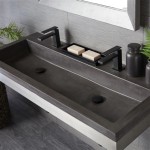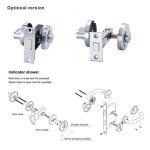What Is The Average Cost of Bathroom Vanity Installation?
Bathroom vanity installation is a common home renovation project, enhancing both the aesthetic appeal and functionality of a bathroom. Understanding the average cost associated with this project is crucial for homeowners planning such an upgrade. The overall cost varies considerably depending on several factors, including the type of vanity, its size, the complexity of the installation, and the geographic location. This article delves into the various components that contribute to the overall cost of bathroom vanity installation, providing a comprehensive overview for informed decision-making.
The figures presented in this article are intended as general guidelines and should not be considered definitive quotes. Actual costs may fluctuate based on specific project requirements and regional economic conditions. It is always advisable to obtain multiple quotes from qualified professionals to accurately estimate the cost for a particular bathroom vanity installation project.
Factors Influencing the Cost of Bathroom Vanity Installation
Several factors influence the final cost of installing a bathroom vanity. These factors can be broadly categorized into material costs, labor costs, and additional costs associated with plumbing or electrical work.
Vanity Type and Material: The type of vanity selected significantly impacts the overall cost. Stock vanities, available at most home improvement stores, are generally the most affordable option. These vanities come in standard sizes and styles. Semi-custom vanities offer a wider range of options in terms of size, style, and finish, resulting in a higher price point. Custom vanities, built to specific dimensions and design preferences, are the most expensive option. They provide the greatest flexibility but require the most significant investment. The material of the vanity also affects the price. Solid wood vanities, known for their durability and aesthetic appeal, are typically more expensive than those made from MDF (Medium-Density Fiberboard) or particleboard. The countertop material, whether it is laminate, granite, quartz, or marble, also influences the overall cost.
Vanity Size and Configuration: The size of the vanity influences the cost, with larger vanities requiring more materials and potentially more complex installation. A single-sink vanity generally costs less than a double-sink vanity. The configuration of the vanity, such as whether it is a freestanding model, a wall-mounted model, or a corner unit, can also affect the installation cost. Wall-mounted vanities, for example, may require additional structural support, increasing the labor involved.
Labor Costs: Labor costs constitute a significant portion of the total installation cost. These costs vary depending on the geographic location, the experience of the installer, and the complexity of the installation. A simple vanity replacement may require minimal labor, while a more complex installation involving plumbing modifications or electrical work will increase the labor costs. Some installers charge an hourly rate, while others provide a fixed quote for the entire project. It is essential to obtain detailed quotes from multiple contractors to compare pricing and ensure transparency regarding the scope of work included.
Plumbing and Electrical Work: Any modifications to existing plumbing or electrical systems will invariably increase the cost of the vanity installation. Re-routing plumbing lines to accommodate a new vanity configuration can be a complex and time-consuming process. Similarly, adding or relocating electrical outlets for lighting or other bathroom fixtures will necessitate the services of a qualified electrician. These additional services contribute significantly to the overall cost of the project.
Removal and Disposal of Old Vanity: The cost of removing and disposing of the existing vanity should also be considered. Some contractors include this service in their overall quote, while others may charge an additional fee. The disposal fee may vary depending on local regulations and the size of the vanity.
Additional Materials and Supplies: Beyond the vanity itself, the installation process requires additional materials and supplies, such as caulk, sealant, screws, and mounting hardware. These costs, while relatively minor compared to the other factors, should still be factored into the overall budget.
Typical Cost Ranges for Bathroom Vanity Installation
The average cost for bathroom vanity installation can range considerably, depending on the factors outlined above. A basic installation, involving a stock vanity replacement without significant plumbing or electrical modifications, may cost between $300 and $800, including the cost of the vanity and labor. A more complex installation, involving a custom vanity or significant plumbing and electrical work, can easily exceed $2,000 or even $5,000. These figures are estimates and can vary based on regional pricing and the specific requirements of the project.
Stock Vanity Installation: The installation of a stock vanity typically involves replacing an existing vanity with a similar-sized unit. The existing plumbing and electrical connections are usually compatible, minimizing the need for modifications. The cost of the vanity itself can range from $100 to $500, depending on the size and material. The labor cost for a basic installation may range from $200 to $300, bringing the total cost to between $300 and $800. This assumes that the old vanity is easily removed and disposed of, and that no significant modifications to the plumbing or electrical systems are required.
Semi-Custom Vanity Installation: Semi-custom vanities offer a wider range of options than stock vanities, allowing for a more personalized design. The cost of a semi-custom vanity can range from $500 to $1,500, depending on the size, material, and finish. The installation cost may be slightly higher than for a stock vanity, ranging from $300 to $500, due to the increased complexity of the installation. The total cost for a semi-custom vanity installation can therefore range from $800 to $2,000. This cost may increase if plumbing or electrical modifications are necessary.
Custom Vanity Installation: Custom vanities are the most expensive option, as they are built to specific dimensions and design preferences. The cost of a custom vanity can range from $1,500 to $5,000 or more, depending on the size, material, and complexity of the design. The installation cost can also be significantly higher, ranging from $500 to $1,000 or more, due to the specialized skills and expertise required for the installation. The total cost for a custom vanity installation can therefore range from $2,000 to $6,000 or more. This cost is often higher than anticipated due to unforeseen challenges discovered during the installation process.
Strategies for Managing Bathroom Vanity Installation Costs
There are several strategies that homeowners can employ to effectively manage the costs associated with bathroom vanity installation. These strategies involve careful planning, comparison shopping, and a willingness to consider alternative options.
Obtain Multiple Quotes: Obtaining multiple quotes from qualified contractors is essential for comparing pricing and ensuring transparency. When requesting quotes, provide contractors with as much detail as possible regarding the scope of the project, including the type of vanity, its size, and any potential plumbing or electrical modifications. Request a detailed breakdown of the costs, including the cost of materials, labor, and any additional fees. This will allow for a more accurate comparison of the quotes.
Consider Stock or Semi-Custom Vanities: Stock and semi-custom vanities are generally more affordable than custom vanities. If budget is a primary concern, consider selecting a stock or semi-custom vanity that meets the aesthetic and functional requirements of the bathroom. These vanities offer a wide range of styles and finishes, and can often be found at home improvement stores or online retailers at competitive prices.
Minimize Plumbing and Electrical Modifications: Minimizing the need for plumbing and electrical modifications can significantly reduce the overall cost of the installation. If possible, select a vanity that is compatible with the existing plumbing and electrical connections. If modifications are necessary, consider relocating the vanity to a different location in the bathroom to minimize the extent of the work required. Consulting with a plumber and electrician early in the planning process can help identify potential cost-saving strategies.
DIY Some of the Work: Depending on experience and skill level, homeowners may be able to handle some aspects of the installation process themselves. For example, homeowners may be able to remove the old vanity and prepare the area for the new installation. However, it is crucial to leave any plumbing or electrical work to qualified professionals, as these tasks require specialized knowledge and expertise. Improperly installed plumbing or electrical systems can lead to costly repairs and potential safety hazards.
Shop Around for Materials: The cost of materials can vary significantly depending on the supplier. Take the time to shop around for the best prices on vanities, countertops, faucets, and other bathroom fixtures. Online retailers often offer competitive prices compared to traditional brick-and-mortar stores. However, it is important to consider shipping costs and return policies when purchasing materials online.
Consider Refacing the Existing Vanity: Rather than replacing the entire vanity, consider refacing the existing unit. Refacing involves replacing the doors, drawer fronts, and hardware, while keeping the existing cabinet structure intact. This can be a cost-effective way to update the look of the bathroom without incurring the expense of a full vanity replacement.
Plan the Project During Off-Peak Seasons: The demand for home renovation services often fluctuates throughout the year. Contractors may offer lower rates during off-peak seasons, such as the winter months, when demand is lower. Planning the project during these periods can potentially result in cost savings.
Factor in Unexpected Costs: It is always prudent to factor in a contingency fund to cover unexpected costs that may arise during the installation process. These costs may include hidden plumbing or electrical issues, unforeseen structural damage, or the need for additional materials. A contingency fund of 10% to 15% of the total budget is generally recommended.
Verify Contractor Licensing and Insurance: Before hiring a contractor, verify that they are properly licensed and insured. This will protect the homeowner in the event of any accidents or damages that may occur during the installation process. Request proof of insurance and check the contractor's license with the appropriate state or local licensing board.
By carefully considering these factors and implementing these cost-saving strategies, homeowners can effectively manage the costs associated with bathroom vanity installation and achieve their desired bathroom renovation within a reasonable budget.

Bathroom Vanity Installation Cost 2024 Average S

How Much Does Bathroom Vanity Installation Cost 2025

Ultimate Guide To Average Cost Install A Bathroom Vanity

Ultimate Guide To Average Cost Install A Bathroom Vanity

How Much Does Bathroom Vanity Installation Cost 2025

Ultimate Guide To Average Cost Install A Bathroom Vanity

Ultimate Guide To Average Cost Install A Bathroom Vanity

Ultimate Guide To Average Cost Install A Bathroom Vanity

Ultimate Guide To Average Cost Install A Bathroom Vanity

Sink Installation Cost New Fixr
Related Posts







